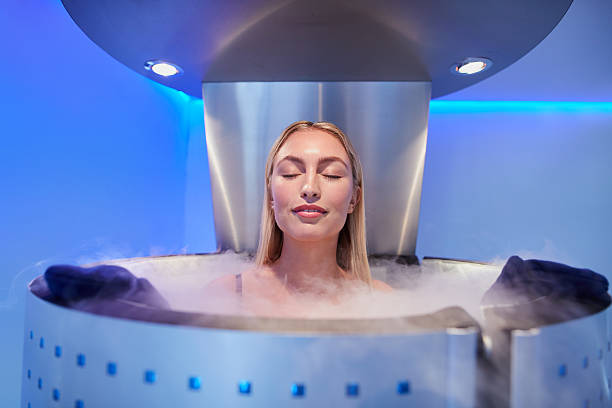Cryotherapy: The Cold Path to Beauty and Wellness
In the ever-evolving landscape of beauty and fitness, a chilling new trend has emerged, captivating the attention of wellness enthusiasts and celebrities alike. Cryotherapy, once reserved for elite athletes and medical treatments, has now stepped into the spotlight as a cutting-edge approach to enhancing both appearance and well-being. This innovative technique harnesses the power of extreme cold to trigger a cascade of physiological responses, promising benefits that range from reduced inflammation to improved skin tone. As more spas and wellness centers incorporate cryotherapy into their offerings, it's becoming clear that this icy treatment is more than just a passing fad – it's a revolution in the way we approach self-care and rejuvenation.

During a cryotherapy session, blood vessels constrict, redirecting blood flow to vital organs. As the body warms up post-treatment, this blood, now enriched with oxygen, nutrients, and enzymes, circulates back through the body. This process is believed to reduce inflammation, boost metabolism, and even stimulate collagen production. The sudden temperature drop also triggers the release of endorphins and other beneficial hormones, contributing to improved mood and energy levels.
From Sports Recovery to Beauty Regimen
Initially popularized in Japan in the 1970s for treating rheumatoid arthritis, cryotherapy has since expanded its reach far beyond the realm of sports medicine. While athletes continue to use it for faster recovery and improved performance, the beauty industry has embraced cryotherapy for its potential anti-aging and skin-rejuvenating effects.
Cryofacials, a localized application of cold therapy to the face, have become increasingly popular in high-end spas and dermatology clinics. These treatments claim to tighten pores, reduce puffiness, and give the skin a more youthful appearance by boosting collagen production. Some practitioners even suggest that regular cryotherapy sessions can help with cellulite reduction and weight loss, although more research is needed to substantiate these claims.
The Cryotherapy Experience
For those brave enough to try whole-body cryotherapy, the experience is often described as invigorating, if not slightly intimidating. Participants typically wear minimal clothing, along with gloves, socks, and slippers to protect extremities from frostbite. As they step into the cryochamber, a rush of frigid air envelops them, causing the skin temperature to drop rapidly.
Despite the extreme cold, most people find the experience tolerable and even enjoyable. The short duration of the treatment prevents the core body temperature from dropping dangerously low, and many report feeling a surge of energy and positivity immediately after the session. This “cryohigh” is attributed to the release of endorphins and the increase in circulation that follows the treatment.
Beyond the Chamber: Cryotherapy at Home
As the popularity of cryotherapy grows, so does the market for at-home cryo-inspired products. Cryotherapy face masks, ice rollers, and cold therapy devices have flooded the beauty market, promising to bring the benefits of professional treatments into the comfort of one’s home. While these products can’t replicate the extreme temperatures of a cryochamber, they offer a more accessible way to incorporate cold therapy into daily skincare routines.
One particularly innovative development is the rise of cryotherapy-inspired skincare ingredients. Cosmetic chemists are now formulating products with cooling agents and ingredients that mimic the effects of cold exposure on the skin. These products claim to tighten pores, reduce redness, and provide an instant refreshing sensation, bringing a touch of cryotherapy to everyday skincare rituals.
The Controversial Chill: Debating Cryotherapy’s Efficacy
Despite its growing popularity, cryotherapy remains a topic of debate in the scientific community. While anecdotal evidence and small-scale studies suggest numerous benefits, large-scale, peer-reviewed research is still limited. Critics argue that many of the purported benefits of cryotherapy, particularly in the realm of beauty and weight loss, are overstated or lack substantial scientific backing.
The U.S. Food and Drug Administration (FDA) has not cleared or approved whole-body cryotherapy devices as safe and effective for treating medical conditions. However, this hasn’t dampened enthusiasm among practitioners and devotees who swear by its results. As with many emerging wellness trends, the truth likely lies somewhere between the hype and the skepticism.
The Future of Cryotherapy in Beauty and Fitness
As research continues and technology advances, the future of cryotherapy in the beauty and fitness industries looks promising. Innovations in cryochamber design are making treatments more comfortable and accessible, while targeted therapies are being developed for specific concerns like hair loss and muscle recovery.
The integration of cryotherapy with other wellness practices is also on the horizon. Some forward-thinking spas are already combining cryotherapy sessions with infrared sauna treatments, creating a hot-cold contrast therapy that promises to amplify the benefits of both. Additionally, personalized cryotherapy protocols based on individual health data and fitness goals are becoming more common, offering a tailored approach to cold therapy.
In conclusion, cryotherapy represents a fascinating intersection of ancient wisdom – the healing power of cold – and cutting-edge technology. As it continues to evolve and integrate into mainstream beauty and fitness practices, cryotherapy challenges us to reconsider our approach to wellness and self-care. Whether it’s a flash-frozen fad or the future of anti-aging, one thing is clear: in the world of beauty and fitness, sometimes it pays to keep your cool.





